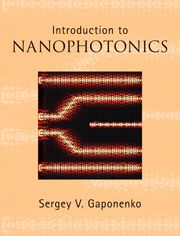Book contents
- Frontmatter
- Contents
- Preface
- Notations and acronyms
- 1 Introduction
- Part I Electrons and electromagnetic waves in nanostructures
- Part II Light–matter interaction in nanostructures
- 13 Light – matter interaction: introductory quantum electrodynamics
- 14 Density of states effects on optical processes in mesoscopic structures
- 15 Light–matter states beyond perturbational approach
- 16 Plasmonic enhancement of secondary radiation
- Author index
- Subject index
13 - Light – matter interaction: introductory quantum electrodynamics
from Part II - Light–matter interaction in nanostructures
Published online by Cambridge University Press: 05 June 2012
- Frontmatter
- Contents
- Preface
- Notations and acronyms
- 1 Introduction
- Part I Electrons and electromagnetic waves in nanostructures
- Part II Light–matter interaction in nanostructures
- 13 Light – matter interaction: introductory quantum electrodynamics
- 14 Density of states effects on optical processes in mesoscopic structures
- 15 Light–matter states beyond perturbational approach
- 16 Plasmonic enhancement of secondary radiation
- Author index
- Subject index
Summary
Generally speaking, fields and matter are the two entities which constitute the Universe. These entities continuously interact. The electromagnetic field is the specific type of field which contains the range of oscillation frequencies which human eyes are able to sense. After twelve chapters in this book, we are now approaching the point where photons enter nanophotonics. Photons are necessary to understand how matter emits light. This happens by means of quantum transitions where matter loses and the electromagnetic field gains a certain portion of energy and momentum. The emission of light, in a broad sense, includes all types of processes where the electromagnetic field gains a portion of energy and momentum from matter. This can be classified as different types of secondary radiation which include emission of photons and scattering of photons. In nanophotonics, these elementary processes of field–matter interaction experience modification because of light-wave confinement, which is typically explained in a rather elegant way as a consequence of the photon density of states modification. The main purpose of the present chapter is to explain the notions of field quantization, photons, emission and scattering rates in terms of quantum transitions and density of electromagnetic modes.
- Type
- Chapter
- Information
- Introduction to Nanophotonics , pp. 377 - 394Publisher: Cambridge University PressPrint publication year: 2010



